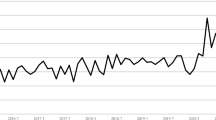Abstract
We propose a model describing consumer demand for a luxury good, in which the perceived quality of the good is related to its scarcity. We use this model to analyze the optimal production and price setting decisions of a luxury good manufacturer and contrast them with the decisions that would be made by a social planner. We show that irrespective of the way social welfare is defined, a monopoly producer of the luxury good may select socially optimal prices and quantity. Thus the incentives of the monopolist and the social planner may to some extent be aligned. We also analyze whether the producer and social planner would be willing to sell the luxury good over the internet if this allowed to increase the number of potential customers for the product. We show that under reasonable assumptions the monopoly producer would not oppose the introduction of internet sales, whilst the social planner may do so, depending on the specification of the model’s parameters. This result is important in the light of the recent revision by the European Commission of its Guidelines on Vertical Restrains (2010).

Similar content being viewed by others
Notes
Sometimes this is called the snob effect, see Leibenstein (1950).
See, for instance, a recent article in The Economist (2010), quoting a few examples.
One can also think of n as the discrete number of consumers. We will use the terms ‘consumer mass’ and ‘number of consumers’ interchangeably.
Indeed, many competition authorities have explicitly stated their ultimate goal as the maximization of consumer welfare and not the total welfare, defined as the sum of consumer and producer surpluses.
For an overview of the theoretical research on this see Lieber and Syverson (2011) and references therein.
Of course, other considerations such as security concerns stemming from the use of the internet channel for distribution and/or adequate presentation on-line may also explain the manufacturers’ attitude.
References
Bagwell, L. S., & Bernheim, B. D. (1996). Veblen effects in a theory of conspicuous consumption. The American Economic Review, 86(3), 349–373.
Bernstein, F., Song, J.-S., & Zheng, X. (2008). “Bricks-and-mortar” vs. “clicks-and-mortar”: An equilibrium analysis. European Journal of Operational Research, 187(3), 671–690.
“Boo Hoo”, The Economist, October 16 2008.
Clark, E., Hughes, M., & Waelbroeck, D. (2009). Selective distribution and luxury goods: The challenge of the internet. The Online Magazine for Global Competition Policy, August 2009, Release 1. Available at http://www.ashurst.com.
Commission Regulation (EC) No 330/2010 of 20 April 2010 on the application of Article 101(3) of the Treaty to categories of vertical agreements and concerted practices, Official Journal of the European Union, L102/1 23 April 2010.
CRA International. (2008a). An economic analysis of the use of selective distribution by luxury goods suppliers—Final report prepared for LVMH group and their legal advisors Cleary Gottlieb Steen and Hamilton. Available at http://ec.europa.eu/competition.
CRA International. (2008b). Selective distribution of luxury goods in the age of e-commerce—An economic report for Chanel. Available at http://ec.europa.eu/competition.
“Death to Discounts? The Designers Rebel”, The Wall Street Journal, April 17 2009.
Frontier Economics. (2008). Economic study of the consumer benefits of e-Bay. Available at http://ec.europa.eu/competition.
Guidelines on Vertical Restraints, Official Journal of the European Union, C130/01, 19 May 2010.
“Handbagged”, The Economist, June 19 2008.
“Hermes Seduces the Elite by Selling Luxury Slowly”, The Wall Street Journal, May 8, 2009.
Leibenstein, H. (1950). Bandwagon, Snob, and Veblen effects in the theory of consumers’ demand. The Quarterly Journal of Economics, 64(2), 183–207.
Lieber, E., & Syverson, C. (2011). Online vs. offline competition. Oxford Handbook of the Digital Economy. Available at http://home.uchicago.edu/~syverson/onlinevsoffline.pdf.
“LVMH wins €40m fight with e-Bay over fakes”, Timesonline, July 1 2008.
“Luxury Brands Survey and Report”, Abrams Research, May 2009. Available at http://www.abramsresearch.com.
Ng, Y.-K. (1987). Diamonds are a government’s best friend: Burden-free taxes on goods valued for their values. The American Economic Review, 77(1), 186–191.
Petrova, S., & Pruzhansky, V. (2011). The economics of luxury goods: Utility based on exclusivity. Social Science Research Network. Available at http://ssrn.com/abstract=1930361.
Rae, J. (1905). The sociological theory of capital. London: The Macmillan Co.
Salans. (2008). Selective distribution of luxury goods in the e-commerce age—Position paper submitted on behalf of Channel. Available at http://ec.europa.eu/competition.
“The Chic learn to click”, The Economist, July 24, 2010.
Trigg, A. (2001). Veblen, Bourdieu and conspicuous consumption. Journal of Economic Issues, 35(1), 99–115.
Veblen, T. (1989). The theory of the leisure class: An economic study of institutions. London: Unwin Books (reprinted New York: Dover, 1994).
“Why a Posh Store Is Selling on e-Bay”, The Wall Street Journal, April 23, 2009.
Yao, S., & Li, K. (2005). Pricing superior goods: Utility generated by scarcity. Pacific Economic Review, 10(4), 529–538.
Acknowledgments
I benefited from discussions with J. J. A. Kamphorst, S. Petrova, M. Trubskyy. The usual disclaimer applies. The views expressed therein are those of the author only and do not necessarily represent the official views of the author’s institution—RBB Economics.
Author information
Authors and Affiliations
Corresponding author
Rights and permissions
About this article
Cite this article
Pruzhansky, V. Luxury goods, vertical restraints and internet sales. Eur J Law Econ 38, 227–246 (2014). https://doi.org/10.1007/s10657-012-9335-2
Published:
Issue Date:
DOI: https://doi.org/10.1007/s10657-012-9335-2




